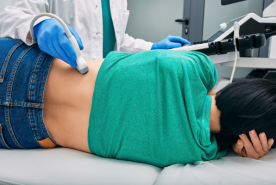Last updated: August 08, 2023
Medically reviewed by: NKF Patient Education Team
Hydronephrosis is a condition that occurs when a kidney swells and can't get rid of pee (urine) like it should
About hydronephrosis
Causes
Hydronephrosis is usually caused by another underlying illness or risk factor. Causes of hydronephrosis include, but are not limited to, the following illnesses or risk factors:
- Kidney stones
- Congenital blockages (a defect that is present at birth)
- Blood clots
- Scarring of tissue (from injury or previous surgery)
- Tumors or certain kinds of cancer (examples include bladder, cervical, colon, or prostate)
- Enlarged prostate (noncancerous)
- Pregnancy
- Urinary tract infection (or other diseases that cause inflammation of the urinary tract)
Complications
In cases of severe blockage due to hydronephrosis, extra urine may need to be removed using either a catheter to drain urine from the bladder or a special tube called a nephrostomy that drains urine from the kidney. The key to treatment is to get it addressed as soon as possible in order to avoid any permanent damage to the kidneys.
Severe hydronephrosis can damage the kidneys and lead to kidney failure. If kidney failure occurs, treatment will be needed with either dialysis or a kidney transplant. When treated quickly, most people recover from hydronephrosis.
Preparing for your appointment
When getting ready to see the doctor, it's good to:
- Write down any symptoms, like pain or frequent peeing
- Make a list of all other health issues and medicines taken
- Bring any test results or medical records you may have to the appointment
Questions to ask
- What's causing my symptoms?
- What tests do I need?
- What treatments are there?
- What are the side effects of treatment?
- Will I need surgery, and if so, what will it be like?
- Will this affect my kidneys in the long run?
- Should I change anything about my lifestyle?
- How can I stop hydronephrosis from happening again?

















